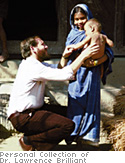Are We Safe?

Ask doctors if they wake up in a cold sweat at night fearing bio-terrorism, and the most knowledgeable will say: "Yes, if it is smallpox." Smallpox is the Big One, according to Dr. Lawrence Brilliant, who helped fight smallpox in India two decades ago—in one of the worst outbreaks in the disease's history.
The History of SmallpoxIf the Guinness Book of World Records had a category for mass murderers, variola major, the virus that causes this highly infectious, terrifying disease, would win easily. In the 20th century alone, smallpox killed more than 300 million people, more than three times the number killed in all wars, and many times the 22 million who have died from AIDS. Our problem today is that while we have no evidence that terrorists have planned smallpox attacks, if they do, we are not immune. Even with the recent good news about the availability of ample vaccine, the specter of battling a full-scale smallpox epidemic is staggering.
Smallpox spreads from person to person, usually by the respiratory route, and is so contagious that any face-to-face exposure to an active case can cause disease. It was named the Small Pox because the boils that appear are tinier than the ones caused by syphilis, the Great Pox. After a few days of sometimes severe flu-like symptoms, pustules develop all over the body, mirroring lesions inside the mouth and other mucous membranes. The pox remain about four weeks—a month of pain and horror. One-third of those afflicted with variola major die, usually from pneumonia; many others are blinded, and the rest are scarred and disfigured (a milder strain, variola minor, is much less fatal). There is no treatment—at least not yet. And for thousands of years, there was no way to prevent the disease. Then, in the 1790s, an English surgeon named Edward Jenner observed that milkmaids who had cowpox—a relatively harmless virus contracted from infected udders—didn't get smallpox. He also discovered that if you injected the pus of a milkmaid's cowpox lesion into the arm of a healthy boy, it would protect him from smallpox. The notion was considered preposterous at the time (Jenner was laughed out of many medical meetings), but it eventually led to the vaccine that has saved millions of lives.
Before the vaccine, smallpox meandered wherever it wanted, leaving peasants, kings and emperors dead in its wake—from Marcus Aurelius to King Louis XV. Even after Jenner's discovery, the disease continued to kill for another 200 years.
What If?
Let's play a game of hypotheticals. Imagine one terrorist releases the smallpox virus, perhaps by aerosol, in Oklahoma City. Because smallpox is invisible, odorless and tasteless, no one knows the virus is present until two weeks later, when the first cases appear. But by then, hundreds more have been exposed and the disease has spread to 25 states and many other countries, afflicting over three million people and causing the death of more than one million. Impossible? This "game" was actually played by policymakers months before the events of September 11, then the anthrax letters put smallpox in the headlines.
Last June, the Center for Strategic and International Studies, the Johns Hopkins Center for Civilian Biodefense Strategies and others conducted a senior-level war game called Dark Winter at Andrews Air Force Base outside Washington, D.C.
The results of Dark Winter convinced many that the devastation caused by smallpox might be worse than an atomic bomb. At the time of the game, we did not have enough vaccine. But even now, should an outbreak occur, less than 20 percent of us are currently protected. Why? We stopped routine vaccinations in 1972 because we assumed smallpox had been relegated to history. Epidemiologists thought the only storehouses of the deadly virus were the two very secure "legal" research labs at the Centers for Disease Control and Prevention (CDC) in Atlanta and Biopreparat in Russia.



